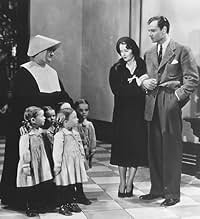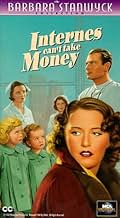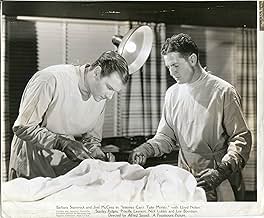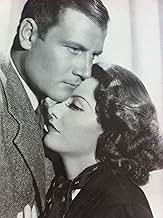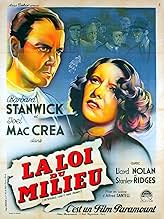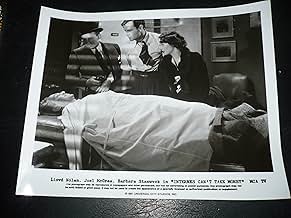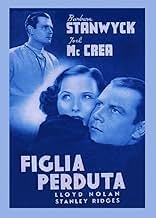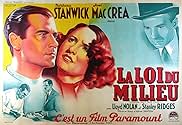IMDb-BEWERTUNG
6,8/10
871
IHRE BEWERTUNG
Füge eine Handlung in deiner Sprache hinzuIn his first film, young Dr. Kildare helps a female ex-con find her child.In his first film, young Dr. Kildare helps a female ex-con find her child.In his first film, young Dr. Kildare helps a female ex-con find her child.
- Regie
- Drehbuch
- Hauptbesetzung
- Auszeichnungen
- 1 wins total
Steve Pendleton
- Interne Jones
- (as Gaylord Pendleton)
James Adamson
- Porter
- (Nicht genannt)
Agostino Borgato
- Popcorn Vendor
- (Nicht genannt)
Helen Brown
- Nurse
- (Nicht genannt)
Empfohlene Bewertungen
The first Dr. Kildare film, from Paramount. It has no connection to the later MGM series, of which I'm a big fan. Despite not having many of the elements I enjoy in those movies, this one is still entertaining. Joel McCrea and Barbra Stanwyck have nice chemistry. Lloyd Nolan and Stanley Ridges are great as gangsters, one rotten and one not so much. The best parts of the film are the hospital scenes that give us lots of "window into the past" bits that show us how life was at the time. Particularly how the medical profession was different. The visual style is more enhanced in these scenes, too. The hospital set is also pretty cool. Probably the one thing this film has over the MGM series. Worth a look whether you are a fan of Kildare or not.
... except this one is from Paramount and stars Joel McCrea as Dr. James Kildare. Like in the MGM series starting the following year, Dr. Kildare is an intern in a large New York City hospital, he lives on subsistence wages, and has a pretty grueling schedule. Unlike the MGM series there is no hot tempered wheelchair bound mentor in the person of one Dr. Gillespie. In all of his judgements here, Kildare is pretty much on his own.
As an intern in the hospital, Kildare treats a young woman for a burn on her hand (Barbara Stanwyck as Janet Haley). She also turns out to be undernourished so Kildare makes her lie down and drink a glass of milk. He then discharges her. It turns out Janet does have a job, she's just been cutting corners including her own meals to save money to pay for stool pigeons to help her find her own three year old child. She had been stolen by her estranged husband to keep her quiet about his illegal activities, but he died after pulling a hold up before he could tell her where the child was. She spent two years in prison because everybody believed she was in on the robbery with her husband.
If this is starting to sound like it is mainly about Stanwyck's character and not so much about Kildare, you would be right. This is mainly Stanwyck's film. But Kildare does figure heavily into helping Janet solve her dilemma. Also figuring heavily into the plot is Kildare's big taste for risk if it helps somebody out. That includes sewing up a gangster (Lloyd Nolan) after he shows up at a cafe and bar near the hospital, stabbed in some underworld activity and requiring immediate medical attention.
I think I prefer Lew Ayres' interpretation of the role, but this film is still worthwhile.
As an intern in the hospital, Kildare treats a young woman for a burn on her hand (Barbara Stanwyck as Janet Haley). She also turns out to be undernourished so Kildare makes her lie down and drink a glass of milk. He then discharges her. It turns out Janet does have a job, she's just been cutting corners including her own meals to save money to pay for stool pigeons to help her find her own three year old child. She had been stolen by her estranged husband to keep her quiet about his illegal activities, but he died after pulling a hold up before he could tell her where the child was. She spent two years in prison because everybody believed she was in on the robbery with her husband.
If this is starting to sound like it is mainly about Stanwyck's character and not so much about Kildare, you would be right. This is mainly Stanwyck's film. But Kildare does figure heavily into helping Janet solve her dilemma. Also figuring heavily into the plot is Kildare's big taste for risk if it helps somebody out. That includes sewing up a gangster (Lloyd Nolan) after he shows up at a cafe and bar near the hospital, stabbed in some underworld activity and requiring immediate medical attention.
I think I prefer Lew Ayres' interpretation of the role, but this film is still worthwhile.
The acting and plot were strong here, and a very enjoyable movie. There is great chemistry with Joel McCrea and Barbara Stanwyck. Stanwyck per norm does great, dramatic work here.
The show stealer is Stanley Ridges. His creep who will help Stanwyck find her child -- only if she sleeps with him long-term and becomes his moll -- is chilling. It's one of the best performances I've ever see of a subtle, sinister gangster who alludes to dastardly deeds, without ever directly saying it. He doesn't ask her to sleep with him, he just munches popcorn, and offers her some. When she declines he says "At some point you should like popcorn." He is direct, firm and sleezy in a must-see performance.
The other scene stealer is Lloyd Nolan. A phenomenal what you would typically like a from a gangster, but with more depth. Great pauses, thoughtfulness and facial expressions in his conversations with McCrea. He's your ideal tough gangster but also has a bit of compassion. Just a bit.
MCrea is always a joy to watch - stable, sure performance.
Internes Can't Take Money is a clear title about the dilemma, and points to the moral quandary to come. But a more compelling title can be found, which that alone, would have made this a more sophisticated movie and higher up in the ranks.
The show stealer is Stanley Ridges. His creep who will help Stanwyck find her child -- only if she sleeps with him long-term and becomes his moll -- is chilling. It's one of the best performances I've ever see of a subtle, sinister gangster who alludes to dastardly deeds, without ever directly saying it. He doesn't ask her to sleep with him, he just munches popcorn, and offers her some. When she declines he says "At some point you should like popcorn." He is direct, firm and sleezy in a must-see performance.
The other scene stealer is Lloyd Nolan. A phenomenal what you would typically like a from a gangster, but with more depth. Great pauses, thoughtfulness and facial expressions in his conversations with McCrea. He's your ideal tough gangster but also has a bit of compassion. Just a bit.
MCrea is always a joy to watch - stable, sure performance.
Internes Can't Take Money is a clear title about the dilemma, and points to the moral quandary to come. But a more compelling title can be found, which that alone, would have made this a more sophisticated movie and higher up in the ranks.
An exceptionally flavorful rendering of the Depression atmosphere: a world of the poor laboring in sweatshop jobs, petty hoods hanging out in smoky bars, backroom bookie joints, pushcart vendors and bus terminals and orphanages. While the plot is no more ambitious than the typical B movie of the time, the high production values, name cast, and imaginative direction from Alfred Santell all boost the quality.
At the center of the plot, Barbara Stanwyck spends much of the film in desperation mode, exhausted from searching for her lost child, beaten down by two years in jail, forced to hire stool pigeons, forced to stay alert.
Joel McCrea makes the ideal American hero for the 30's: not only a doctor, but tall, blond, honest, sincere, manly, and progressive. At one point, he has to perform an operation on a bar room table, improvising with violin strings, an ice pick, and a bottle of rum! But this is not MGM's Dr. Kildare. He has no warm relationship with a kindly old mentor; instead, the chief doctor is an authority figure upholding the rules, dismissing Lee Bowman for unauthorized experimentation. The script also pumps up sympathy for interns as underpaid workers who get only $10 a month.
As a gangster, the always fascinating Stanley Ridges conveys the calm of a man secure in his power, whose eye movements size up his adversaries and whose silences reveal more menace than mere words. Watch the sexual innuendo he finds in his "I didn't always like popcorn" speech.
Santell uses extreme close-ups and moves the camera often, aided by gleaming lighting from Theodore Sparkuhl, plus some knock-out sets, including a sparkling white Art Deco clinic and an elaborately detailed New York Irish bar. Watch how economically Santell works to show the awakening of mutual attraction between Stanwyck and McCrea in their first scene together. Also lifting the picture out of its formula origins is the headlong pace Santell maintains to the climax, an urgency lost in the blander MGM series.
At the center of the plot, Barbara Stanwyck spends much of the film in desperation mode, exhausted from searching for her lost child, beaten down by two years in jail, forced to hire stool pigeons, forced to stay alert.
Joel McCrea makes the ideal American hero for the 30's: not only a doctor, but tall, blond, honest, sincere, manly, and progressive. At one point, he has to perform an operation on a bar room table, improvising with violin strings, an ice pick, and a bottle of rum! But this is not MGM's Dr. Kildare. He has no warm relationship with a kindly old mentor; instead, the chief doctor is an authority figure upholding the rules, dismissing Lee Bowman for unauthorized experimentation. The script also pumps up sympathy for interns as underpaid workers who get only $10 a month.
As a gangster, the always fascinating Stanley Ridges conveys the calm of a man secure in his power, whose eye movements size up his adversaries and whose silences reveal more menace than mere words. Watch the sexual innuendo he finds in his "I didn't always like popcorn" speech.
Santell uses extreme close-ups and moves the camera often, aided by gleaming lighting from Theodore Sparkuhl, plus some knock-out sets, including a sparkling white Art Deco clinic and an elaborately detailed New York Irish bar. Watch how economically Santell works to show the awakening of mutual attraction between Stanwyck and McCrea in their first scene together. Also lifting the picture out of its formula origins is the headlong pace Santell maintains to the climax, an urgency lost in the blander MGM series.
A wildly improbable drama, the misspelled "Internes Can't Take Money" was the first in the "Dr.Kildare" movie series, which was subsequently recast with Lew Ayres in the title role and continued at the MGM studio, following this initial Paramount effort. Concocted by writer Max Brand, the story involves an honest young intern at a large hospital, who crosses paths with a widowed ex-con seeking to locate her three-year-old daughter, who was abducted by her deceased bank-robber husband. The recipe is an old one; toss in a couple of shady characters and a gangster with a heart of gold, who is embroiled in illegal betting, add a tolerant landlady and a kindly bartender, sprinkle with nuns, mix with unexpected twists, and bake until overdone.
Despite an uninspired title and a routine script, director Alfred Santell maintains a steady pace that will distract viewers from the at-times laughable plot turns that lead to a teary fade-out, provoked either by laughter or sentiment. Beyond the script, the film's technical aspects are quite good, especially the black and white cinematography by Theodor Sparkuhl, who often dramatically captures Stanwyck garbed in deep black, contrasting with McCrea, dressed in his intern's whites.
Barbara Stanwyck plays the widow, Janet Haley, and the actress, at her sudsy distraught-mother best, is convincing in an unconvincing role. Joel McCrea is the original Dr. Kildare, a straight-arrow intern, poorly paid and burdened by work and rules, who seeks solace at a nearby bar, where his life takes a sudden turn. Stanwyck and McCrea, in their third co-starring film, work well together, and Stanwyck seems genuinely taken with McCrea during their first scene together. Attesting to what makes a film star a star, Stanwyck and McCrea add dimension and interest to otherwise cardboard characters in credibility-stretching situations. In addition to the two stars, the capable cast also includes Lloyd Nolan, Stanley Ridges, and Charles Lane. However, if not for the professionalism and charisma of the leads and supporting players, "Internes Can't Take Money" would be 80 minutes of laughable coincidences and plot turns, memorable only as the first in the Dr. Kildare movie series.
Despite an uninspired title and a routine script, director Alfred Santell maintains a steady pace that will distract viewers from the at-times laughable plot turns that lead to a teary fade-out, provoked either by laughter or sentiment. Beyond the script, the film's technical aspects are quite good, especially the black and white cinematography by Theodor Sparkuhl, who often dramatically captures Stanwyck garbed in deep black, contrasting with McCrea, dressed in his intern's whites.
Barbara Stanwyck plays the widow, Janet Haley, and the actress, at her sudsy distraught-mother best, is convincing in an unconvincing role. Joel McCrea is the original Dr. Kildare, a straight-arrow intern, poorly paid and burdened by work and rules, who seeks solace at a nearby bar, where his life takes a sudden turn. Stanwyck and McCrea, in their third co-starring film, work well together, and Stanwyck seems genuinely taken with McCrea during their first scene together. Attesting to what makes a film star a star, Stanwyck and McCrea add dimension and interest to otherwise cardboard characters in credibility-stretching situations. In addition to the two stars, the capable cast also includes Lloyd Nolan, Stanley Ridges, and Charles Lane. However, if not for the professionalism and charisma of the leads and supporting players, "Internes Can't Take Money" would be 80 minutes of laughable coincidences and plot turns, memorable only as the first in the Dr. Kildare movie series.
Wusstest du schon
- WissenswertesBarbara Stanwyck asked director Al Santell to cast Joel McCrea as her leading man, having worked with him twice before. "I want this guy," she told him. "He's going to be a good leading man."
- PatzerDuring the bar-room conversation (c.16 minutes) the coffee cup on the table disappears, re-appears and moves between shots.
- Zitate
Bookie: Maybe it's the cops.
"Chief" Hanlon: Cops don't knock, they break in.
- VerbindungenFollowed by Dr. Kildare - Sein erster Fall (1938)
Top-Auswahl
Melde dich zum Bewerten an und greife auf die Watchlist für personalisierte Empfehlungen zu.
- How long is Internes Can't Take Money?Powered by Alexa
Details
- Erscheinungsdatum
- Herkunftsland
- Sprache
- Auch bekannt als
- Internes Can't Take Money
- Drehorte
- Manhattan, New York City, New York, USA(Second unit opening credits)
- Produktionsfirma
- Weitere beteiligte Unternehmen bei IMDbPro anzeigen
- Laufzeit1 Stunde 18 Minuten
- Farbe
- Seitenverhältnis
- 1.37 : 1
Zu dieser Seite beitragen
Bearbeitung vorschlagen oder fehlenden Inhalt hinzufügen

